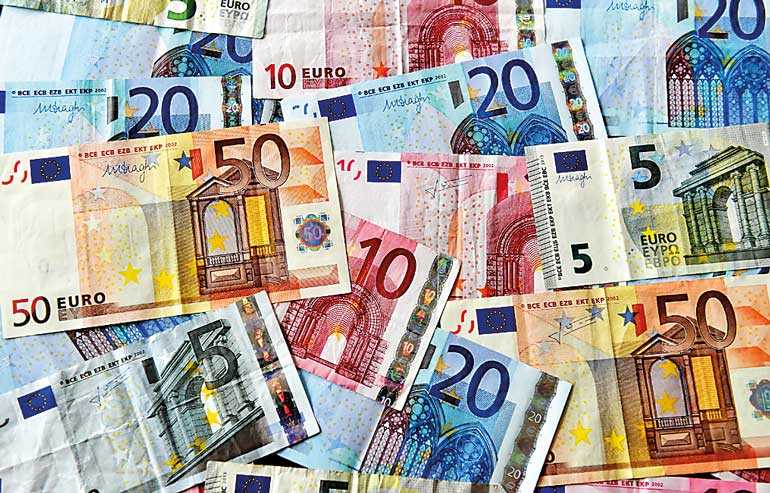Sunday Apr 20, 2025
Sunday Apr 20, 2025
Monday, 31 December 2018 00:47 - - {{hitsCtrl.values.hits}}

PARIS (AFP): The euro was launched on 1 January 1999, at first only for accounting and financial transactions, and then three years later as notes and coins.
Here is a recap of defining moments for the currency, which was envisaged in the European Union’s Maastricht Treaty.
Conversion rate
On 31 December 1998, on the eve of the euro launch, the definitive conversion rates are revealed by the new European Central Bank: one euro will buy 1.95583 Deutschmarks, 6.55957 French francs and 1,936.27 Italian lire.
Tens of thousands of people in banks and European stock exchanges get to work over the New Year break to ensure everything is ready when financial markets reopen on 4 January.
Shops that displayed prices in both currencies with approximate exchange rates update their tags.
Official currency
On 1 January 1999 the euro becomes the official currency for 291 million people in 11 countries: Austria, Belgium, Finland, France, Germany, Ireland, Italy, Luxembourg, The Netherlands, Portugal and Spain.
The new money can be used for bank transfers along with payments by cheque, traveller’s cheque and bank card. Monday, 4 January is the euro’s baptism on foreign exchange markets. One euro initially trades for more than $1.18. But weeks later it slides to less than a dollar and at the end of October it hits its lowest rate ever, at $0.8230.
On 1 January 2001 Greece becomes the 12th country to adopt the single currency.
Coins and notes
On 1 January 2002 the euro becomes physical legal tender as some 15 billion notes and more than 50 billion coins are put into circulation, shaking up the lives of 304 million Europeans.
People familiarise themselves with the single currency, sometimes using pocket calculators to make it easier to work out conversions.
Unlike most currencies, the euro notes show no national symbols, opting instead for bridges and windows. A period of two legal tenders being in circulation in each country begins as the national currencies are gradually phased out, lasting until 1 March. On 15 July the euro reaches parity with the dollar again.
More countries
In 2003 Sweden, in a referendum, joins Denmark and Britain in rejecting the single currency.
Elsewhere, new EU member countries adopt the single currency: Slovenia in 2007, Cyprus and Malta in 2008, Slovakia in 2009, Estonia in 2011, Latvia in 2014 and Lithuania in 2015.
Debt crisis
On 15 July 2008 the euro reaches an exchange rate high, trading at $1.6038 as the United States is rocked by the subprime mortgage crisis. That November, however, the eurozone enters a recession lasting a year. In 2010 the EU is mired in a debt crisis. In May the EU and International Monetary Fund (IMF) provide a 110-billion-euro bailout for Greece, which in turn commits to a severe austerity plan. A month later the euro plunges below $1.20.
In November, Ireland, where banks are crippled by debt, also obtains an EU-IMF bailout plan of 85 billion euros. Portugal obtains a 78-billion-euro bailout in May 2011.
Saving the euro
On 25 July 2012 Spain’s long-term interest rate soars above 7.6%, sparking fears of a euro collapse. A day later European Central Bank chief Mario Draghi promises to do “whatever it takes to preserve the euro”.
In August, in one week, the ECB buys back bonds of eurozone nations worth 22 billion euros to support Italy and Spain.
The EU agrees in October to cancel a part of the Greek debt and to extend a new set of loans.
Avoiding ‘Grexit’
In May 2014 the single currency rises near $1.40, hitting exports. Then months later it comes close to $1.05 in a slide that is linked to the buying of assets by the ECB to support the economy.
In July the next year Greece obtains a third bailout aimed at keeping it from crashing out of the eurozone, or “Grexit”.
‘Bin Laden’ banknotes
In 2016 the ECB says it plans to stop issuing the 500-euro note by the end of 2018. The banknote is known as the “Bin Laden” and believed to be favoured by criminals for money laundering and terrorist financing.
Discover Kapruka, the leading online shopping platform in Sri Lanka, where you can conveniently send Gifts and Flowers to your loved ones for any event including Valentine ’s Day. Explore a wide range of popular Shopping Categories on Kapruka, including Toys, Groceries, Electronics, Birthday Cakes, Fruits, Chocolates, Flower Bouquets, Clothing, Watches, Lingerie, Gift Sets and Jewellery. Also if you’re interested in selling with Kapruka, Partner Central by Kapruka is the best solution to start with. Moreover, through Kapruka Global Shop, you can also enjoy the convenience of purchasing products from renowned platforms like Amazon and eBay and have them delivered to Sri Lanka.
Discover Kapruka, the leading online shopping platform in Sri Lanka, where you can conveniently send Gifts and Flowers to your loved ones for any event including Valentine ’s Day. Explore a wide range of popular Shopping Categories on Kapruka, including Toys, Groceries, Electronics, Birthday Cakes, Fruits, Chocolates, Flower Bouquets, Clothing, Watches, Lingerie, Gift Sets and Jewellery. Also if you’re interested in selling with Kapruka, Partner Central by Kapruka is the best solution to start with. Moreover, through Kapruka Global Shop, you can also enjoy the convenience of purchasing products from renowned platforms like Amazon and eBay and have them delivered to Sri Lanka.